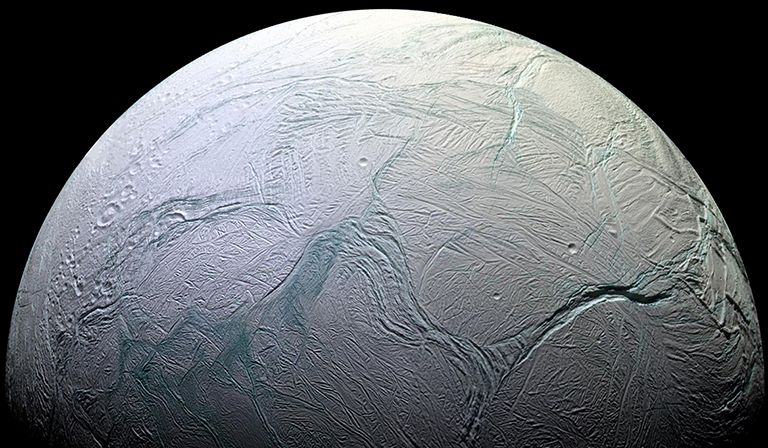Enceladus Contains a Huge Subsurface Ocean
At 500 kilometers in diameter, Enceladus is only the sixth largest of Saturn’s 62 moons. It has been confirmed that it contains a huge subsurface ocean, making it one of the solar system’s most promising candidates for extra-terrestrial life.

In the journal Science, astronomers from NASA and Caltech published evidence that little Enceladus has a giant underground, or rather under-ice, ocean. This new evidence reinforces what astronomers have been theorizing since 2005 when NASA’s Cassini spacecraft first observed giant geyser-like plumes of water erupting near Enceladus’s south pole. They thought pressure changes due to the moon’s irregular orbit might be forcing water from an underground ocean up through cracks in its icy surface, but they weren’t sure because there was no evidence for a source of heat that would keep the ocean liquid, and there could’ve been other explanations for those plumes.
Since then, Cassini has flown by Enceladus 19 times in three flybys and sent particularly clear radio signals back to Earth. These signals indicated something confusing about Enceladus’s gravity. A region near the south pole of the moon turned out to have a stronger gravitational field than it should have. Such abnormalities can usually be explained by large masses like mountains or by differences in crust composition, but this region actually has a giant depression in it, and Enceladus’s crust is just frozen water. But a dense region under the ice would account for this anomaly, and what’s denser than ice? Liquid water, 7% denser than ice to be exact. So scientists think this change in gravitation is caused by a hidden ocean with about the same volume as Lake Superior. According to some complicated math, they estimate that the ocean is about ten kilometers deep sitting beneath an ice shell that’s about 30 to 40 kilometers thick. This would also explain the depression around Enceladus’s south pole. If the ice crust melted into water, it would reduce its volume, making a dent.
So all the evidence points to an underground ocean and therefore the possibility of habitability because not only is there liquid water, which life is really into, but there’s rock underneath it in Enceladus’s core. Liquid water interacting with a rocky bed means chemical reactions that could produce nutrients. All that’s missing is an energy source. And if Enceladus is tectonically active, as last week’s findings also suggest, with a core, mantle and crust of rock, water and, ice all moving around creating friction with one another, that could be an energy source right there. Extremophiles here on Earth, like archaea, use reactions driven by geothermal energy to get by very nicely.
So as a candidate for life, Enceladus is looking pretty promising competing with the likes of another of our favorites, Europa, a moon of Jupiter which astronomers also predict has a liquid subsurface ocean and which has also been observed releasing plumes of water. NASA is putting together preliminary plans for a robotic probe to Europa, but with Enceladus joining the ocean club, they’re gonna have to decide where to put their money.
Credit: [scishow space]